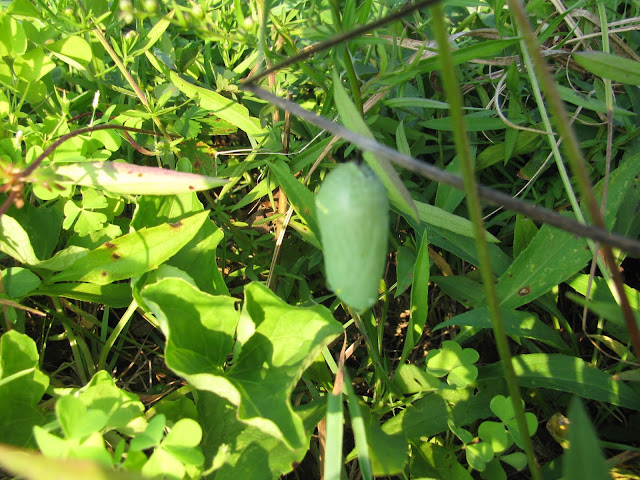Notes
on Starting a Butterfly Garden – The Monarch Project @ Mercer Road Farm
Just as the bees are in decline, other
pollinators – the butterflies (especially Monarchs) are also rapidly
disappearing. This is thought to be from
a combination of the eradication of the monarch caterpillar’s primary food
source (milkweed) and other farming practices.
Large swaths of the U.S. are planted with plants that are genetically
modified (GMO) to withstand herbicides. These
herbicides like Roundup (containing glyphosate) kill milkweed. By the way…
glyphosate is also a probable carcinogen (cause of cancer). Millions (some estimate billions) of monarchs
have vanished and their population has been reduced by over 96 percent in
recent years.
 |
Yellow Coneflower - Ratibita Pinnata |
We decided to build a series of butterfly gardens on our blueberry farm. We do not
use any chemicals on the farm, so we thought that it would be a nice safe haven
for the monarchs to rest and reproduce.
I had planted a small test garden last year (cheated and used many
plants that had already been started – from Prairie Moon). We have poor clay soil and it is very
difficult to grow anything. I also had planted purple prairie clover, yellow clover, brown eyed susan, Bush's coneflower, culver's root and red monarda (bee balm - I think that the deer ate this). That garden turned out really well – pictured above.
 |
August - disappointing growth of the milkweed that were planted from seed. However the monarch caterpillars LOVED the plants!!!!!!! |
 |
A third butterfly garden -- slow milkweed growth but the monarch caterpillars loved it anyway. |
I had also bought a large number of wildflower
and milkweed seeds for other planned gardens.
We got caught by the early snow and could not clear and plow the areas
before winter started and so did not get to put the seeds down in late fall. I put the milkweed seeds in potting soil and
stored them in a refrigerator so that I could plant them in the spring. I did plant most of the milkweed and some of
the wildflower seeds. I was extremely disappointed
in the slow start and slow growth of the milkweed plants (see pictures above). However, I am still hoping that they will
come back in the spring. I will let you
know.
Even though I was disappointed in the plants the
butterflies must have loved them. I went
down to hand weed the crabgrass out of one garden and was surprised in late
August to find a caterpillar almost every foot or so. !!!!!!!! Very happy !!!!!!!! I only found a few chrysalis, but I did have one side of each garden surrounded by large a large unmowed field, so I hope that this is where they built the chrysalis. I did see many large monarch butterflies in the ensuing weeks.
Here
are some notes and observations:
1. You
must choose an area that you will not mow (at least not after early spring). You might have to weed by hand – at least
make sure that no trees are growing.
2.
Sometimes the caterpillars go “off the reservation” therefore be careful
not to mow them or step on them. I was
mowing next to the butterfly garden earlier in the summer. After seeing the caterpillars around the garden,
I have decided this year to surround the gardens with plants that crowd out
weeds/grass and do not need mowing. I
will try variegated mint and regular mint as well as Echinacea. I hope that the caterpillars aren’t bothered
by the mint. I will report back on this.
Butterflies seem to LOVE Echinacea and it grows anywhere for me.
3. If at
all possible, plant the milkweed in the fall (instructions can be found at
Prairie Moon Farm website and other places).
Otherwise you must follow the instructions for chilling them before
planting. Note that I do not agree with
the use of “nontoxic” chemicals to kill weeds and prepare the bed.
4. Plant
wildflowers and let wild sedge and other nice wild plants grow with the
milkweed. Try to plant with a density
that will allow the wildflower and milkweed to crowd out other plants.
5. Don’t
step in the garden when you see caterpillars.
They may be everywhere and are difficult to see sometimes. When the butterflies emerge, do not handle
them. They need time to hang upside down
to inflate their wings.
6. The
monarch caterpillar can only feed on milkweed but the butterfly will feed on nectar
from many kinds of flowers. Try to keep
as many native wildflowers around as you can manage.
7. Note
that most wildflowers do not bloom the first year. It may take a few years before the garden
looks like a wildflower garden.
Here is a list of the seeds that were ordered last year and a picture of the wildflowers and milkweed plants.
Here is a list of the seeds that were ordered last year and a picture of the wildflowers and milkweed plants.





No comments:
Post a Comment